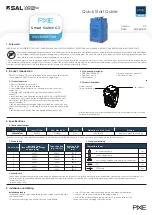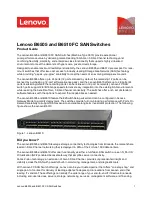
CONGRATULATIONS
on your purchase of the Radial Pro48 active direct
box. As with all Radial products the Pro48 is easy to use. This short manual
contains all the information you need to start using the Pro48 right away. For
more information on the Pro48 and other Radial products, visit our website at
www.radialeng.com.
OVERVIEW
The Pro48 is a great sounding active direct box. It has been optimized to
produce maximum headroom and dynamics while working within the limited
current available from 48V phantom power.
The Pro48 employs a unique switching power supply that steps up the current
from phantom power to produce higher internal rail voltage than typical
active DIs. This makes the Pro48 capable of peak input transients to 9 volts
without any noticeable distortion, making it perfect for both active and passive
instruments. The Pro48 is equipped with an input PAD to help prevent overload
from hot signals and a ground lift to reduce noise caused by ground loops. The
balanced XLR output can drive very long cables without appreciable signal
loss. The Pro48 is constructed for heavy use in the studio and on stage.
Pro48 BLOCK DIAGRAM
To fully understand the Pro48 follow the block diagram from the inputs on the
left to the outputs on the right.
Pro48 User Guide
Radial Engineering
Pro48 User Guide
Radial Engineering
Pro48 User Guide
Radial Engineering
CONNECTING THE Pro48
Before connecting the Pro48, start by making sure all volume levels are set
to zero. This will avoid any loud pops in your sound system that could cause
driver damage. Confi rm the Pro48 switches are in their ‘out’ position.
Begin by connecting your instrument to the 1⁄4” INPUT jack on the Pro48. The
instrument signal may be connected through the Pro48 to an amplifi er using
the 1⁄4” THRU jack.
Finally, connect the LOW-Z OUT to the input of a microphone snake or mixing
console using a balanced XLR cable. The Pro48 can drive very long cable in
excess of 300 feet without signal loss.
FREQUENTLY ASKED QUESTIONS
What is the difference between active & passive?
Active DI’s have a built-in pre-amp requiring power to run while passive DI’s use
a transformer to convert the signal. Both transform or convert the instrument’s
high-impedance output to a low impedance balanced microphone level. This
allows long cable runs without adding unwanted noise. Passive boxes have the
advantage of providing isolation over typical DIs, which can reduce ground hum
and noise in systems. The Pro48 features an isolation transformer in the power
supply to address this problem.
Which is better - active or passive?
Both have their place just like dynamic and condenser microphones. Passive
DIs are often easier to use because they do not require power while, active
DIs tend to have more reach. As a rule, passive direct boxes are best suited
for electrically powered devices like keyboards, while active boxes are often
preferred for instruments like acoustic guitars and basses.
What makes the Radial Pro48 so special?
Let’s begin by understanding how active DI’s work: active direct boxes are in fact
preamplifi ers. They boost the instrument’s signal to a manageable level. This
means that active direct boxes require power to run. As such, they must either
get their power from batteries or phantom power from the console.
When using batteries, they must be fresh for the direct box to work properly. As
soon as the power is low, the direct box will distort. This is why engineers hate
batteries and prefer phantom power. But phantom has limitations; phantom power
was originally developed to supply low-current condenser microphones. The
AES specifi cation for phantom is 48 volts with only a few milliamps of current.
We tested a popular acoustic guitar with built-in pre-amp and found that when
pushed to the max, the output peaked at 7 volts. Considering that most DI’s
can barely manage 3 volts, its no wonder guitars often sound harsh in a PA
system. The Radial Pro48 was specifi cally designed to solve this problem by
increasing the internal rail voltage so that these high output instruments would
not overload the DI’s input.
How does Radial increase the rail voltage?
We take the phantom power voltage and drive it through a special custom
made DC-to-DC transformer. The transformer is coupled to a timing chip that
essentially drives the signal the same way as the newer switch mode or digital
power amplifi ers work. This brings the current up to a workable level and creates
a higher internal rail voltage to handle the dynamics.
What is phantom power?
Phantom power is a 48 volt DC supply that comes from the mixing console that
was originally designed to provide power to condenser microphones. The Radial
Pro48 takes the phantom power and converts it using an internal switching power
supply. This allows the Pro48 to handle higher transients without the distortion
associated with most active direct boxes.
Mic-level
Thru
USING THE Pro48
Once your cables are connected, turn on the phantom power source. The LED
on the Pro48 will light to confi rm phantom power is present and the Pro48 is
active. Start at a low volume to make sure everything is working properly be-
fore increasing the level.
If you encounter distortion, check the input level at your mixer fi rst. If your
mixer controls appear normal, try depressing the input PAD switch on the
Pro48. This will reduce the input level by -15dB.
If you encounter any buzz or hum, try lifting the ground switch on the Pro48
with the LIFT switch. This interrupts the signal ground between the input and
output to reduce hum and buzz caused by ground loops.
Now close your eyes and rediscover the sound of your instrument.
After the paralleled input and thru jacks the signal passes through a switchable
15dB PAD which allows the Pro48 to handle virtually any audio device from
passive pickups to CD players without overloading.
Next comes the active drive circuit that converts the signal to balanced low
impedance mic-level for transmission over long cables without noise or signal
loss. The switching PSU steps up the current from phantom power and the
drive circuit uses the higher rail voltage to increase headroom and dynamic
range.
The switching PSU uses a transformer in the DC path to block noise caused
by ground loops. The ground LIFT switch interrupts the ground path around the
transformer to help suppress noise from bleeding through into the audio path.




















